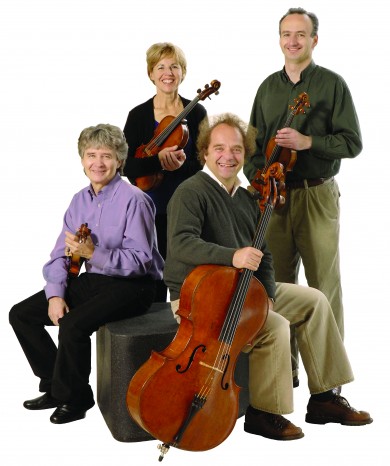Takács Quartet delivers first-class performance at Kravis Center

The Takacs Quartet performed music of Haydn, Debussy and Beethoven Thursday night at the Kravis Center in West Palm Beach.
Four students at Budapest’s famed Franz Liszt Academy of Music came together in 1975 to play string quartets.
Today the Takács Quartet is one of the world’s most eminent chamber ensembles, with two of its original members, second violinist Károly Schranz and cellist András Fejér, still in the group after nearly 40 years.
The quartet appeared Thursday at the Kravis Center for the Performing Arts in West Palm Beach, where the musicians gave gripping performances of works by Haydn, Debussy and Beethoven.
They opened with Haydn’s String Quartet in B flat major, Op. 64, no. 3, one of those sunny, optimistic works Haydn composed as he was saying farewell to the life of a livery-clad servant in a noble household and striking off as an independent composer.
The first movement fully captured Haydn at his most amiable, with first violinist Edward Dusinberre playing the piquant main theme over a jaunty, galloping accompaniment in the other instruments.
The ensuing Adagio was a revelation, showing how musicians could bring a glowing, amber warmth to their playing without exceeding Classical-era musical and emotional proportions. The final movement was less impressive, largely because the quick notes of the opening melody—and each time it was repeated—were indistinct and mushy.
Nothing could be further from the light, outward-looking confidence of the Haydn quartet than the fog-shrouded, harmonically ambiguous work that followed, Debussy’s String Quartet in G Minor. The musicians brought a shimmery, glossy tone to the first movement, playing in a manner that maximized the mistiness of the work, but with a propulsive, pulsing force that prevented the performance from becoming too indistinct.
In the second movement, they played in a manner that brought out how weird this pillar of the repertoire must have sounded in its 1893 premiere, the opening pizzicato going with an almost wild energy. Without doing anything to disturb the smooth surface, they emphasized the sudden, screeching high notes and their tortured harmonies. Moments later, the tones of Dusinberre’s violin floated serenely over a rustling accompaniment.
The Debussy performance was a model of subtle shadings of tone, ensemble precision and musical commitment. The surging power of their playing never marred the luminous sound projected by the quartet.
The concert ended with Beethoven’s String Quartet Op. 59, No. 2, one of the group known as the “Razumovsky” quartets. This is classic middle-period Beethoven, with terse motifs, high drama and long-lined melodies, and the Takács ensemble gave a fine performance.
The opening movement was tense and hard-driving, with the musicians playing with the sort of tight ensemble unity so important in bringing off this sort of music. They performed the gruff, two-note motif that opens the work and recurs repeatedly with broad, emphatic bow strokes and a dramatic pause, underlining these notes in a manner that emphasized their importance to the movement.
The Molto Adagio was wonderfully played, with great depth and richness of tone in the long, hushed melodies. They performed the third movement Allegretto with a pointed elegance, giving a sinister lilt to the dance-like minor-key melody. The opening of the Presto finale sounded a bit constricted. But this movement also contained some of the ensemble’s most absorbing playing, particularly a passage in which a three-note motif was bounced softly from instrument to instrument in a long passage of mounting tension brought off with virtuoso precision.
Posted in Performances
Leave a Comment
Fri Dec 12, 2014
at 11:39 am
No Comments






